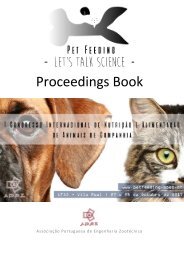Book of Proceedings I PetFeeding
Create successful ePaper yourself
Turn your PDF publications into a flip-book with our unique Google optimized e-Paper software.
39<br />
should be clearly recorded to avoid malnourishment. Determining the exact amounts consumed<br />
when fed with bottles is difficult as gradation on bottles is not in small increments and printed<br />
milliliter lines easily fade after a couple <strong>of</strong> washes. Getting the weight <strong>of</strong> the bottle or the baby<br />
before and after on a kitchen scale (1 g is about 0.97 ml <strong>of</strong> milk) or using a large syringe to<br />
measure consumption is best.<br />
Some babies do not have adequate suckling reflex soon enough or are too malnourished to<br />
ingest adequate quantities <strong>of</strong> formula. The tube feeding via orogastric tube can be safely and<br />
easily done to replace a few feedings until the neonate is strong enough to sustain suckling. The<br />
tube should be measured from the last rib to the tip <strong>of</strong> the nose with the head extended and<br />
marked at this point. Inserting the tube at this length, with the head now flexed, ensures it is in<br />
the stomach and not the lungs or the esophagus, but instilling a few milliliters <strong>of</strong> water first,<br />
before administering formula is a good habit. Kink the tubing to avoid introducing air if using<br />
several syringes to administer formula and when removing the tube to avoid aspiration.<br />
It is easier for the first feedings to keep the neonate in sternal recumbency at caretaker’s<br />
chest level on the table, for example, onto and covered with a s<strong>of</strong>t blanket, for ease <strong>of</strong><br />
observation so proper technique can be learned. The head can be cradled in the palm <strong>of</strong> the hand<br />
and slightly elevated, but neck should be flexed, not overextended. The nipple placed straight<br />
into baby’s mouth, so the air is not sucked in with the milk. Caution should be exercised to<br />
prevent neonate from getting too cold during the feeding, especially if milk is spilled over his<br />
chest and front paws. Until 3 weeks <strong>of</strong> age, the neonates should be stimulated to defecate and<br />
urinate after each feeding by gently touching a piece <strong>of</strong> damp (warm water) cotton wool to their<br />
perineum. The general steps <strong>of</strong> the feeding process are preparing the formula and supplies,<br />
elimination, weighing, feeding, burping, weighing and perhaps another feeding and elimination.<br />
Check genital area for diarrhea or evidence <strong>of</strong> suckling by siblings. Daily record <strong>of</strong> neonates<br />
weight should be kept. As a rough estimate, they should gain their birth weight every week until<br />
weaning or 2.5 -5 gm per kg <strong>of</strong> anticipated adult weight each day.<br />
If baby has aspirated, the milk will come through his nostrils. Immediately, all milk has to<br />
be aspirated out <strong>of</strong> the nostrils with a human baby nose aspirator. Ideally, the neonates head<br />
should be below his body to help gravity keep the milk out <strong>of</strong> his lungs. Aspirated baby needs<br />
close monitoring over the next 24 hours. If clicking noise is heard upon respiration (well in<br />
advance <strong>of</strong> labored breathing), the intensive medical therapy for aspiration pneumonia should<br />
be initiated immediately.<br />
Puppy or kitten food can be introduced at 3 to 4 weeks <strong>of</strong> age, by <strong>of</strong>fering a gruel <strong>of</strong> food<br />
mixed with milk replacer in a flat dish (for easy access and to prevent drowning). Water should<br />
also be <strong>of</strong>fered. Smearing a bit <strong>of</strong> food onto neonates’s lips can entice them to lick the food.<br />
Neonates chin or front paw can be gently nudged into the gruel for the first taste, taking care<br />
not to get any food around the nostrils. By the age <strong>of</strong> 6 weeks orphan kitten and puppies can be<br />
completely weaned. Change in texture, bulk <strong>of</strong> the ingesta, exposure to new protein,<br />
carbohydrate and fat sources are stressful for the GI. Rapid introduction <strong>of</strong> solid food can<br />
negatively affect the microbial population or lead to dehydration.<br />
The first litter box for kittens should contain litter safe to ingest, so no clumping litter! The



